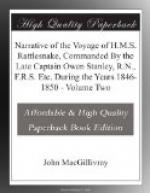Cape Rodney: Latitude 10 degrees 3 minutes 32 seconds South, Longitude 147 degrees 45 minutes 45 seconds East.
Cape Hood: Latitude 9 degrees 58 minutes 6 seconds South, Longitude 147 degrees 22 minutes 50 seconds East.**
(Footnote. Voyage round the world in His Majesty’s frigate Pandora, performed under the direction of Captain Edwards in the years 1790, 1791 and 1792 by Mr. G. Hamilton, late surgeon of the Pandora, page 100.)
(**Footnote. Ibid page 164. Krusenstern assumes these longitudes to be 45 minutes too far to the westward, adopting Flinders’ longitude of Murray’s Islands, which differs by that amount from Captain Edwards’.)
CAPTAINS BLIGH AND PORTLOCK.
In the following year, Captains Bligh and Portlock, in the Providence and Assistance, conveying breadfruit plants from Tahiti to the West Indies, saw a portion of the south-east coast of New Guinea, when on their way to pass through Torres Strait. A line of coast extending from Cape Rodney to the westward and northward about eighty miles, the latter half with a continuous line of reef running parallel with the coast, is laid down in a chart by Flinders,* as having been “seen from the Providence’s masthead, August 30th 1792.”
(Footnote. Flinders’ Voyage to Terra Australis Atlas Plate 13.)
ADMIRAL D’ENTRECASTEAUX.
The northern portion of the Louisiade Archipelago was yet unknown to Europeans, and for almost all the knowledge which we even now possess regarding it, we are indebted to the expedition under the command of Rear-Admiral Bruny d’Entrecasteaux, who, on June 11th, 1793, with La Recherche and L’Esperance, during his voyage in search of the unfortunate La Perouse, came in sight of Rossel Island. The hills of that island were enveloped in clouds, and the lower parts appeared to be thickly wooded with verdant interspaces. A harbour was supposed to exist in the deep bay on the north coast of Rossel Island, but access to it was found to be prevented by a line of breakers extending to the westward as far as the eye could reach. D’Entrecasteaux passed Piron’s Island, which he named, as well as various others, and on St. Aignan’s observed several huts, and the first inhabitants of the Louisiade whom they had seen, for, at Renard’s Isles, a boat sent close in to sound, had observed no indications of natives, although smoke was afterwards seen rising from the largest of the group. At the Bonvouloir Islands, they had the first communication with the natives, who came off in a very large canoe and several others which approached near enough for one of the officers of L’Esperance to swim off to them. The natives showed much timidity and could not be induced to come on board the frigate. Some sweet-potatoes and bananas were given in return for various presents. No arms were seen among them, and these people did not appear to understand the use of iron.* The remainder of the voyage does not require further notice here, as the D’Entrecasteaux Isles of the charts belong to the north-east coast of New Guinea.




